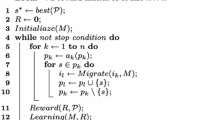Abstract
This paper investigates a new heterogeneous method that dynamically sets the migration period of a distributed Genetic Algorithm (dGA). Each island GA of this multipopulation technique self-adapts the period for exchanging information with the other islands regarding the local evolution process. Thus, the different islands can develop different migration settings behaving like a heterogeneous dGA. The proposed algorithm is tested on a large set of instances of the Max-Cut problem, and it can be easily applied to other optimization problems. The results of this heterogeneous dGA are competitive with the best existing algorithms, with the added advantage of avoiding time-consuming preliminary tests for tuning the algorithm.
Similar content being viewed by others
References
Alba E (2005) Parallel metaheuristics: a new class of algorithms. Wiley, New York
Alba E, Dorronsoro B (2005) The exploration/exploitation tradeoff in dynamic cellular genetic algorithms. IEEE Trans Evol Comput 9(2):126–144
Alba E, Troya JM (2000) Influence of the migration policy in parallel distributed GAs with structured and panmictic populations. Appl Intell 12(3):163–181
Alba E, Luna J, Moreno LM, Pablos C, Petit J, Rojas A, Xhafa F, Almeida F, Blesa MJ, Cabeza J, Cotta C, Díaz M, Dorta I, Gabarró J, León C (2002) MALLBA: a library of skeletons for combinatorial optimisation. LNCS, vol 2400. Springer, Berlin, pp 927–932
Anjos MF (2001) New convex relaxations for the maximum cut and VLSI layout problems. PhD thesis, University of Waterloo
Anjos M, Liers F (2010) Global approaches for facility layout and vlsi floorplanning. Handbook of semidefinite, cone and polynomial optimization: theory, algorithms, software and applications, p 32
Arráiz E, Olivo O (2009) Competitive simulated annealing and tabu search algorithms for the Max-Cut problem. In: GECCO ’09: proceedings of the 11th annual conference on genetic and evolutionary computation. ACM, New York, pp 1797–1798
Barahona F, Grötschel M, Jünger M, Reinelt G (1988) An application of combinatorial optimization to statistical physics and circuit layout design. Oper Res 36(3):493–513
Belding TC (1995) The distributed genetic algorithms revisited. In: Proceedings of the sixth international conference on genetic algorithms, pp 114–121
Brdiczka O, Maisonnasse J, Reignier P, Crowley JL (2009) Detecting small group activities from multimodal observation. Appl Intell 30(1):47–57
Burer S, Monteiro RDC, Zhang Y (2002) Rank-two relaxation heuristics for Max-Cut and other binary quadratic programs. SIAM J Optim 12(2):503–521
Chen Y, Crawford M, Ghosh J (2004) Integrating support vector machines in a hierarchical output space decomposition framework. In: Proceeding of IEEE international geoscience and remote sensing symposium, vol 2, pp 949–952
Crainic TG, Tolouse M (2003) Parallel metaheuristics. In: Crainic TG, Laporte G (eds) Fleet management and logistics. Kluwer Academic, Dordrecht, pp 205–251
Crainic TG, Tolouse M (2003) Parallel strategies for metaheuristics. In: Glover FW, Kochenberger GA (eds) Handbook of metaheuristics. Kluwer Academic, Dordrecht, pp 475–514
Cung V, Martins SL, Ribeiro CC, Roucairol C (2003) Strategies for the parallel implementation of metaheuristics. In: Ribeiro CC, Hansen P (eds) Essays and surveys in metaheuristics. Kluwer Academic, Dordrecht, pp 263–308
Deza M, Laurent M (1994) Applications of cut polyhedra I. Comput Appl Math 55(2):191–216
Deza M, Laurent M (1994) Applications of cut polyhedra II. Comput Appl Math 55(2):217–247
Ding CHQ, He X, Zha H, Gu M, Simon HD (2001) A min-max cut algorithm for graph partitioning and data clustering. In: Proceedings IEEE international conference on data mining, pp 107–114
Du Z, Jeong Y-S, Jeong MK, Kong SG (2011) Multidimensional local spatial autocorrelation measure for integrating spatial and spectral information in hyperspectral image band selection. Appl Intell. doi:10.1007/s10489-010-0274-8
Festa P, Pardalos PM, Resende MGC, Ribeiro CC (2002) Randomized heuristics for the MAX-CUT problem. Optim Methods Softw 7:1033–1058
Goemans MX, Williamson DP (1995) Improved approximation algorithms for maximum cut and satisfiability problems using semidefinite programming. J ACM 42(6):1115–1145
Helmberg C, Rendl F (2000) A spectral bundle method for semidefinite programming. SIAM J Optim 10(3):673–696
Heragu SS, Kusiak A (1988) Machine layout problem in flexible manufacturing systems. Oper Res 36(2):258–268
Hung C-C, Kuo B-C, Chi M-H, Hsieh T-Y (2006) A comparison of hierarchical classification processes based on hyperspectral image. In: IEEE international geoscience and remote sensing symposium, pp 948–951
Kahruman S, Kolotoglu E, Butenko S, Hicks IV (2007) On greedy construction heuristics for the max_cut problem. Int J Comput Sci Eng 3(3):211–218
Karp R (1972) Reducibility among combinatorial problems. In: Miller R, Thatcher J (eds) Complexity of computer computations. Plenum, New York, pp 85–103
Kuo B-C, Chi M-H, Yang J-M, Yang C-W (2007) Hierarchical classification systems for hyperspectral image classification. In: IEEE international geoscience and remote sensing symposium, pp 1745–1748
Luna F, Alba E, Nebro AJ (2005) Parallel metaheuristics. A new class of algorithms. In: Alba E (ed) Parallel heterogeneous metaheuristics. Wiley, New York, pp 395–422
Martí R, Duarte A, Laguna M (2009) Advanced scatter search for the Max-Cut problem. INFORMS J Comput 21(1):26–38
Özyer T, Alhajj R (2009) Parallel clustering of high dimensional data by integrating multi-objective genetic algorithm with divide and conquer. Appl Intell 31(3):318–331
Picard J-C, Queyranne M (1981) On the one-dimensional space allocation problem. Oper Res 29(2):371–391
Saha S, Bandyopadhyay S (2010) Automatic MR brain image segmentation using a multiseed based multiobjective clustering approach. Appl Intell. doi:10.1007/s10489-010-0231-6
Suryanarayanan JK, Golden BL, Wang Q (1991) A new heuristic for the linear placement problem. Comput Oper Res 18(3):255–262
Tanese R (1989) Distributed genetic algorithms. In: Proceedings of the third international conference on genetic algorithms, pp 434–439
Verma B, Hassan SZ (2009) Hybrid ensemble approach for classification. Appl Intell 34(2):258–278
Author information
Authors and Affiliations
Corresponding author
Rights and permissions
About this article
Cite this article
Salto, C., Alba, E. Designing heterogeneous distributed GAs by efficiently self-adapting the migration period. Appl Intell 36, 800–808 (2012). https://doi.org/10.1007/s10489-011-0297-9
Published:
Issue Date:
DOI: https://doi.org/10.1007/s10489-011-0297-9




